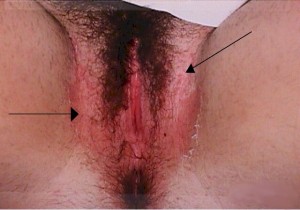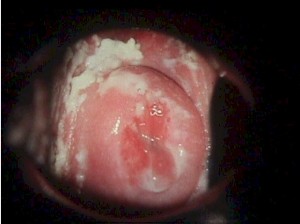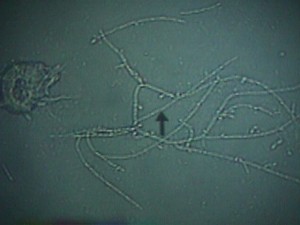Vaginal yeast infections are common, monilial overgrowths in the vagina and vulvar areas, characterized by itching, dryness, and a thick, cottage-cheese appearing vaginal discharge.
The vulva may be reddened and irritated to the point of tenderness.

Yeast thrives in damp, hot environments and women in such circumstances are predisposed toward these infections.Women who take broad-spectrum antibiotics are also predisposed towards these infections because of loss of the normal vaginal bacterial flora.

Yeast organisms are normally present in most vaginas, but in small numbers.
A yeast infection, then, is not merely the presence of yeast, but the concentration of yeast in such large numbers as to cause the typical symptoms of itching, burning and discharge. Likewise, a “cure” doesn’t mean eradication of all yeast organisms from the vagina. Even if eradicated, they would soon be back because that is where they normally live. A cure means that the concentration of yeast has been restored to normal and symptoms have resolved.

The diagnosis is often made by history alone, and enhanced by the classical appearance of a dry, cheesy vaginal discharge. It can be confirmed by microscopic visualization of clusters of thread-like, branching Monilia organisms when the discharge is mixed with KOH.
Treatment*
Short-course topical formulations (i.e., single dose and regimens of 1–3 days) effectively treat uncomplicated VVC. The topically applied azole drugs are more effective than nystatin. Treatment with azoles results in relief of symptoms and negative cultures in 80%–90% of patients who complete therapy.
Recommended Regimens
Over-the-Counter Intravaginal Agents:
- Clotrimazole 1% cream 5 g intravaginally daily for 7–14 days
OR - Clotrimazole 2% cream 5 g intravaginally daily for 3 days
OR - Miconazole 2% cream 5 g intravaginally daily for 7 days
OR - Miconazole 4% cream 5 g intravaginally daily for 3 days
OR - Miconazole 100 mg vaginal suppository, one suppository daily for 7 days
OR - Miconazole 200 mg vaginal suppository, one suppository for 3 days
OR - Miconazole 1,200 mg vaginal suppository, one suppository for 1 day
OR - Tioconazole 6.5% ointment 5 g intravaginally in a single application
Prescription Intravaginal Agents:
- Butoconazole 2% cream (single dose bioadhesive product), 5 g intravaginally in a single application
OR - Terconazole 0.4% cream 5 g intravaginally daily for 7 days
OR - Terconazole 0.8% cream 5 g intravaginally daily for 3 days
OR - Terconazole 80 mg vaginal suppository, one suppository daily for 3 days
Oral Agent:
- Fluconazole 150 mg orally in a single dose
The creams and suppositories in these regimens are oil-based and might weaken latex condoms and diaphragms. Refer to condom product labeling for further information. Intravaginal preparations of clotrimazole, miconazole, and tioconazole are available over-the-counter (OTC). Even women who have previously received a diagnosis of VVC by a clinician are not necessarily more likely to be able to diagnose themselves; therefore, any woman whose symptoms persist after using an OTC preparation or who has a recurrence of symptoms within 2 months after treatment for VVC should be clinically evaluated and tested. Unnecessary or inappropriate use of OTC preparations is common and can lead to a delay in the treatment of other vulvovaginitis etiologies, which can in turn result in adverse outcomes.
Follow-Up
Follow-up typically is not required. However, women in whom symptoms persist or recur after treatment of initial symptoms should be instructed to return for follow-up visits.
Management of Sex Partners
Uncomplicated VVC is not usually acquired through sexual intercourse; thus, data do not support treatment of sex partners. A minority of male sex partners have balanitis, characterized by erythematous areas on the glans of the penis in conjunction with pruritus or irritation. These men benefit from treatment with topical antifungal agents to relieve symptoms.
Special Considerations
Allergy, Intolerance, and Adverse Reactions
Topical agents usually cause no systemic side effects, although local burning or irritation might occur. Oral azoles occasionally cause nausea, abdominal pain, and headache. Therapy with the oral azoles has been associated rarely with abnormal elevations of liver enzymes. Clinically important interactions can occur when oral azoles agents are administered with other drugs.
Complicated VVC
Diagnostic Considerations
Vaginal cultures should be obtained from women with complicated VVC to confirm clinical diagnosis and identify unusual species, including nonalbicans species, particularly Candida glabrata. (C. glabrata does not form pseudohyphae or hyphae and is not easily recognized on microscopy.) Although C. albicans azole resistance is possibly becoming more common in vaginal isolates, susceptibility testing is usually not warranted for individual treatment guidance.
Recurrent Vulvovaginal Candidiasis
Recurrent Vulvovalginal Candidiasis (RVVC), usually defined as four or more episodes of symptomatic VVC within 1 year, affects a small percentage of women (<5%). The pathogenesis of RVVC is poorly understood, and most women with RVVC have no apparent predisposing or underlying conditions. C. glabrata and other nonalbicans Candida species are observed in 10%–20% of women with RVVC. Conventional antimycotic therapies are not as effective against these nonalbicans species as against C. albicans.
Treatment
Each individual episode of RVVC caused by C. albicans responds well to short duration oral or topical azole therapy. However, to maintain clinical and mycologic control, some specialists recommend a longer duration of initial therapy (e.g., 7–14 days of topical therapy or a 100-mg, 150-mg, or 200-mg oral dose of fluconazole every third day for a total of 3 doses [day 1, 4, and 7]) to attempt mycologic remission before initiating a maintenance antifungal regimen.
Oral fluconazole (i.e., 100-mg, 150-mg, or 200-mg dose) weekly for 6 months is the first line maintenance regimen. If this regimen is not feasible, topical treatments used intermittently can also be considered. Suppressive maintenance therapies are effective in reducing RVVC. However, 30%–50% of women will have recurrent disease after maintenance therapy is discontinued. Symptomatic women who remain culture-positive despite maintenance therapy should be managed in consultation with a specialist.
Severe VVC
Severe vulvovaginitis (i.e., extensive vulvar erythema, edema, excoriation, and fissure formation) is associated with lower clinical response rates in patients treated with short courses of topical or oral therapy. Either 7–14 days of topical azole or 150 mg of fluconazole in two sequential oral doses (second dose 72 hours after initial dose) is recommended.
Nonalbicans VVC
Because at least 50% of women with positive cultures for nonalbicans Candida might be minimally symptomatic or have no symptoms and because successful treatment is often difficult, clinicians should make every effort to exclude other causes of vaginal symptoms in women with nonalbicans yeast. The optimal treatment of nonalbicans VVC remains unknown. Options include longer duration of therapy (7–14 days) with a nonfluconazole azole regimen (oral or topical) as first-line therapy. If recurrence occurs, 600 mg of boric acid in a gelatin capsule is recommended, administered vaginally once daily for 2 weeks. This regimen has clinical and mycologic eradication rates of approximately 70%. If symptoms recur, referral to a specialist is advised.
Management of Sex Partners
No data exist to support the treatment of sex partners of patients with complicated VVC. Therefore, no recommendation can be made.
Special Considerations
Compromised Host
Women with underlying immunodeficiency, those with poorly controlled diabetes or other immunocompromising conditions (e.g., HIV), and those receiving immunosuppression therapy (e.g., corticosteroid treatment) do not respond as well to short-term therapies. Efforts to correct modifiable conditions should be made, and more prolonged (i.e., 7–14 days) conventional treatment is necessary.
Pregnancy
VVC occurs frequently during pregnancy. Only topical azole therapies, applied for 7 days, are recommended for use among pregnant women.
HIV Infection
Vaginal Candida colonization rates among women with HIV infection are higher than among seronegative women with similar demographic and risk behavior characteristics, and the colonization rates correlate with increasing severity of immunosuppression. Symptomatic VVC is also more frequent in women with HIV infection and similarly correlates with severity of immunodeficiency. In addition, among women with HIV infection, systemic azole exposure is associated with the isolation of nonalbicans Candida species from the vagina.
On the basis of available data, therapy for uncomplicated and complicated VVC in women with HIV infection should not differ from that for seronegative women. Although long-term prophylactic therapy with fluconazole at a dose of 200 mg weekly has been effective in reducing C. albicans colonization and symptomatic VVC (727), this regimen is not recommended for women with HIV infection in the absence of complicated VVC. Although VVC is associated with increased HIV seroconversion in HIV-negative women and increased HIV cervicovaginal levels in women with HIV infection, the effect of treatment for VVC on HIV acquisition and transmission remains unknown.
*CDC 2015 STD Treatment Guidelines
